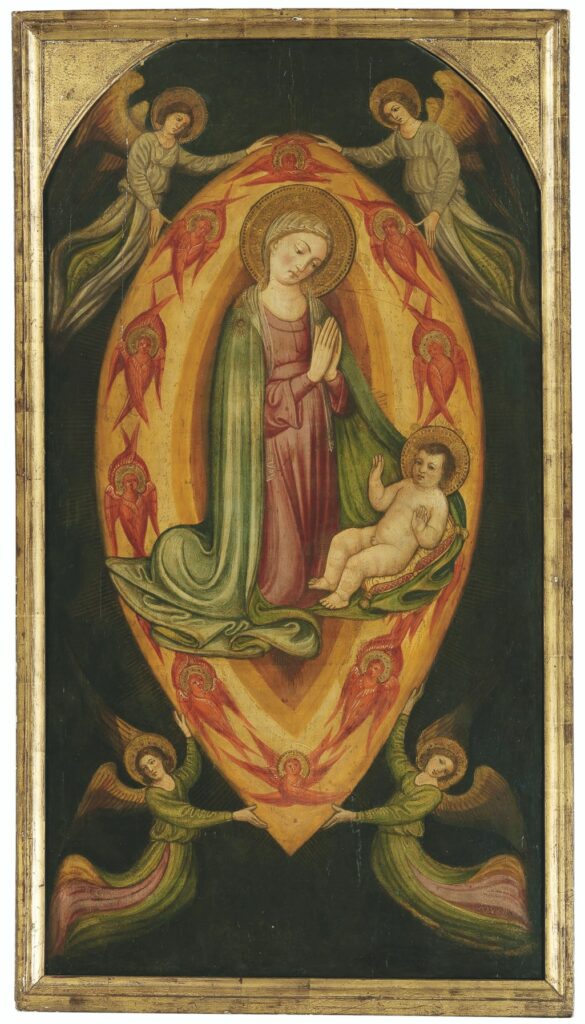It’s in the Cards: The Future is Female

This will be the last card in my year-long commitment to the Tarot as a reader. While I have learned much, I am left with a question.
If I am the reader, who is the subject of my reading?
As a man, I think this card may offer a reading for men in general because it may be understood to herald a fundamental shift in their societal status.
Gentlemen, be seated.
The card you see on the table before you is called “The World,” usually associated with momentous change. The message is hard to miss, framed by symbols of the Christian gospels, one evangelist in each corner. We know that “gospel” translates as “good news,” and it is good news indeed if you have grown weary of the burden of being an Alpha Male 24/7. It is good news for you and good news for women because it suggests that a historical reckoning is about to take place.
There was a time, according to Joseph Campbell and Maria Gimbutas, when the divine principle was female and operated under the aegis of the Goddess. She had many names and Campbell loved to recite them: Artemis, Ishtar, Astarte, Anahit, Aphrodite, and Mary who, while not a deity herself, is clearly the dominant member of her odd marriage to a local carpenter.
Read more
But, as James Hillman liked to say, the gods never show up alone. Each member of the female pantheon partnered with some male divine which, while full of potency, is nevertheless a secondary character in a supportive role. Just as Barbie has Ken, Ishtar has Tammuz, Inanna claims Dumuzi, Venus delights in her Adonis, Isis is unavoidably linked to corpse-like Osiris, and Mary enjoys a Platonic marriage of convenience with a local craftsman.
My point is that patriarchy is never a permanent state but a condition always in flux which can leave us in positions of public power, or reduce us to ancillary functions. Consider Mary and Joseph. She is Theotokos, or “god bearer.” He’s good at miter cuts.
The current epoch of male hegemony began one afternoon when Persephone was plucking a narcissus from the meadow where she and her all female crew were gamboling under the eye of a watchful mother goddess, Demeter, whose attention wandered just long enough to allow a chthonic kidnapper to burst through the mantle of the earth, urging his unblinking horses onward to capture the lovely Persephone.
Is it more than a story? I think so. That momentous afternoon speaks of the abruptness by which one monad supplanted another. I have always intuitively felt that Hades’ abduction of Persephone is a historical echo of those very real thundering hooves under the saddles of the Indo-Europeans in 4400 BCE, a date favored by Gimbutas, who cites as evidence the artifacts she found from that period among the broken shards and abandoned granaries of her digs.
“Weapons, weapons, weapons!” cries the Lithuanian archeologist to her interviewer from the L.A. Times (6/11/89). “It’s just incredible how many thousands of pounds of these daggers and swords were found from the Bronze Age. This was a cruel period and the beginning of what it is today—you turn on the television, and it’s war, war, war, whatever channel.”
The invaders brought more than daggers. They came with their deities. Derived from guardian family gods throughout the second millennium BCE, they pillaged the sleepy Neolithic towns throughout southeastern Europe and Asia Minor to the Indus Valley.
“The chief gods of the invaders were predominantly male warrior gods, champions, each, of his special people. Those of the invaded agricultural territories, in contrast, were chiefly of the earth’s fertility and life, local forms for the most part, of the one great ‘goddess of many names,’ of whom all beings, even gods and demons, are the progeny” (Inner 46).
So goodbye village and tillage, hello horse and battle ax.
But the historical reckoning which I see in the card before me is now upon us. The mandorla, Campbell reminds us in Tarot Revelations, is comprised of overlapping circles, their point of intersection creating a Venn diagram or, if one prefers, an almond such as we see framing the central figure of the face card. “Moreover, the form of the mandorla is traditionally interpreted as a reference to the female organ of birth, the vulva, as though the cosmic mother-goddess of all space-time were here to be seen giving birth to the Christ of the Second Coming, and thereby to the Kingdom of the Father which is within us.”
Only, the “Father” is noticeably absent within the mandorla. The evangelists are heralding a woman, although the figure can be construed (with effort) as a hermaphrodite. Either way, the second coming will be a rude awakening for those whose prayers are still directed to a male god residing somewhere just beyond the moon.
In the subject’s hands are, respectively, a wand to the left, indicative of the male principle, according to Campbell, and a conch shell to the right, symbolic of the female principle.
But the reassuring balance is undermined by the displacement of Christ altogether. As Campbell directs our attention to the West Portal of Chartres Cathedral, we discover a remarkably similar constellation of symbolic representations: Four Evangelists with a central Christ framed by a mandorla.
The meaning of Card 21 could not be clearer: A woman is giving the hip-check to the boy from Bethlehem.
The pivot from gynocentrism to phallocentrism can happen in an instant, as when Hades drags his unwilling prey to an undesired throne in Hell. Or it can occur naturally over centuries: I am thinking of another “hermaphrodite” whose career began in India as the mustachioed male Avalokiteshvara, but, by the time he gets to China and Japan, has become the most merciful Kuan Yin, holding in her sublime hands, not the conch of card No 21, but the “vase of her compassion” which she pours out upon the suffering earth.
“In our present day,” writes Campbell in apparent sympathy with the premise of imminent historical transition, “it does indeed seem that a fundamental transformation of the historical conditions of its inhabiting humanity is in prospect, and that the age of the conquering armies of the contending monster monads… may be about to close” (Inner, 16).
Not a moment too soon.
 After a successful career as a television writer in the 1970s and '80s with such credits as M*A*S*H and Maude, John's interest in story became increasingly academic. He transitioned to a new field, music, with a Masters in Conducting, then earned a PhD in Mythology from Pacifica University.
After a successful career as a television writer in the 1970s and '80s with such credits as M*A*S*H and Maude, John's interest in story became increasingly academic. He transitioned to a new field, music, with a Masters in Conducting, then earned a PhD in Mythology from Pacifica University.
His main musical ensemble, Shantigarh, emphasizes a wide range of liturgical music styles, and its membership swells to as many as one hundred voices when they present John's original score for Mass at the Cathedral of Our Lady of the Angels in downtown Los Angeles, CA, at an event broadcast nationally each January.
Weekly Quote
It may well be that a good deal of what has been advertised as representing the will of “Old Man” actually is but the heritage of a lot of old men, and that the main idea has been not so much to honor God as to simplify life by keeping woman in the kitchen.
Featured Video
News & Updates
In this episode George Mumford sits down with Tyler Lapkin of the Joseph Campbell Foundation. George Mumford’s deeply moving personal story is unforgettable. An aspiring basketball player at the University of Massachusetts (where he roomed with Dr. J, Julius Erving), injuries forced Mumford out of the game he loved. The medications that relieved the pain of his injuries also numbed him to the emptiness he felt without the game and eventually led him to heroin. After years of making meditation on and off the cushion the center of his life and getting clean, Mumford enrolled in Dr. Jon Kabat-Zinn’s Mindfulness Based Stress Reduction program and collaborated with him to create the Inner-city Stress Reduction Clinic in the early nineties. When Michael Jordan left the Chicago Bulls to play baseball in 1993, the team was in crisis. Coach Phil Jackson, a long-time mindfulness practitioner, contacted Dr. Kabat-Zinn to find someone who could teach mindfulness techniques to the struggling team—someone who would have credibility and could speak the language of his players. Kabat-Zinn led Jackson to Mumford and their partnership began. Mumford has worked with Jackson and many of the teams he coached to become NBA champions. His roster of champion clients has since blossomed way beyond basketball to include corporate executives, Olympians, and athletes in many different sports. To learn more about George, visit his website: https://georgemumford.com/
Featured Work
Inner Reaches of Outer Space, The
Developed from a memorable series of lectures delivered in San Francisco, which included a legendary symposium at the Palace of Fine Arts with astronaut Rusty Schweickart, this book–the last Campbell completed in his lifetime–explores the space age. Campbell posits that the newly discovered laws of outer space are actually at work within human beings as well and that a new mythology is implicit in this realization. He examines the new mythology and other questions in these essays.
Subscribe to JCF’s email list to receive a weekly MythBlast newsletter along with occasional news and special offers from JCF.





